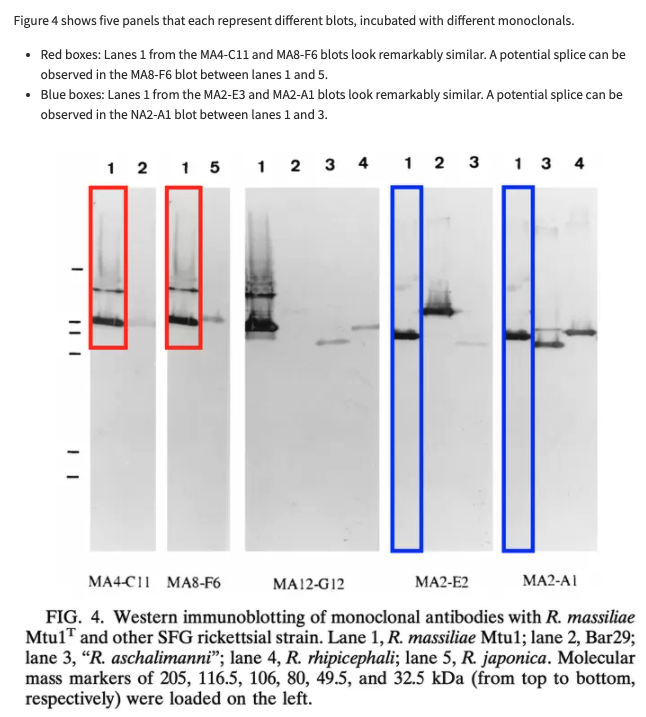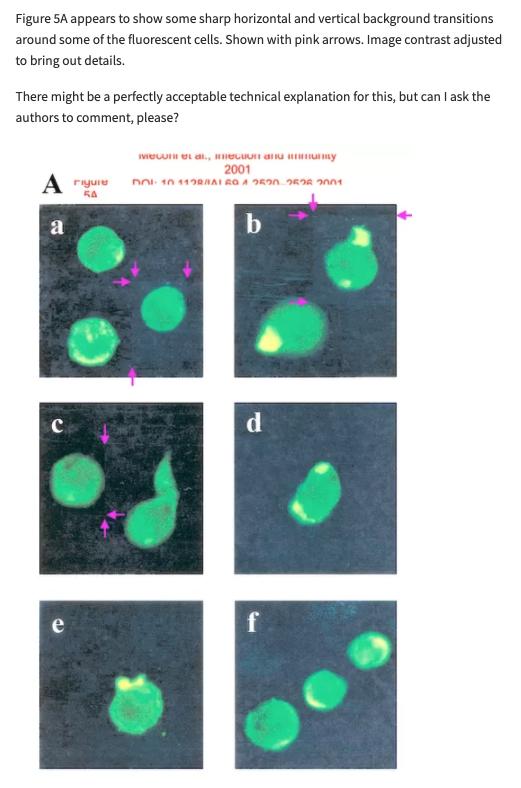Last March, I shared my concerns about a paper from the IHU-Méditerranée Infection (IHUMI)/ Aix-Marseille University (AMU) claiming that Hydroxychloroquine in combination with Azithromycin could reduce coronavirus viral loads faster than no treatment.
Other papers by this group of researchers led by Professor Didier Raoult and/or his right-hand man Professor Eric Chabrière, also appear to contain problems, ranging from potentially duplicated images to ethical concerns.
In this blog post I have gathered the papers by the Raoult and Chabrière group that have image concerns. This post is not an accusation of misconduct, but a compilation of the potential problems found in 22 different papers by this group. I welcome the authors removing any concerns by providing the original figures.
Concerns about duplicated images
A set of at least 22 papers from the AMU/IHUMI group appear to have problematic images, including unexpected similarities across or even within figure panels. All of these have been posted on Pubpeer, including nineteen that I found and posted there. As of today the authors have not replied to most of these PubPeer posts, nor have they corrected the errors.
Category I duplications
Some papers, such as DOI: 10.1093/ajcp/101.3.318 [PubPeer] or 10.1016/j.ijid.2006.10.005 [PubPeer] appear to contain ‘simple’ duplications in figure panels. As explained in a previous post, I call these Category I duplications, where the exact same photo is used to represent two different experiments. These kinds of simple duplications can often be honest errors, where something went wrong during the paper submission or manuscript handling. A cheerful “Oops, yes you are right, we made an error” would have been enough, and these duplicated panels could be easily addressed with a Corrigendum. Unfortunately, the authors have not replied to most of the PubPeer posts.

Figures 1 and 2 appear to show the same photo

Panels b and c look more similar to each other than expected

Figure 2 appears to be identical too Figure 1 in https://doi.org/10.4269/ajtmh.12-0212 [PubPeer]
as noted by François-Xavier Coudert
In DOI 10.1002/jcb.22135 [PubPeer], the two 32h flow cytometry panels look unexpectedly similar, while the gated percentages are different. One of the authors initially replied on Pubpeer and Twitter that the two images did not look identical, but later admitted they looked ‘intriguingly similar’.

where two panels look very similar but have different gated percentages
The same photo appears to have been used in two papers, DOI: 10.1016/j.nmni.2017.12.006 [PubPeer] where it represents Bacillus salis bacteria, and DOI: 10.1002/mbo3.638 [PubPeer] where it represents Gracilibacillus timonensis bacteria.

Category II duplications
Two papers in this set contain Category II duplications, where images overlap or might have been rotated, mirrored, etc.
DOI 10.4269/ajtmh.15-0436 [PubPeer] has been corrected after posting it on PubPeer. In this paper, three of the four panels shown in Figure 1 were showing the same specimen. The aspect ratio of these overlapping areas, marked below with blue and magenta boxes, was not always the same. It appears the images might have been stretched differently, which would be unexpected if the errors were unintentional. Yet, the journal accepted a new set of panels in the July 2020 correction. The authors wrote: “These resulted from errors by a researcher that were missed by other authors. Specifically, a single image was inappropriately inserted to represent three different experiments.“

Three panels appear to overlap with each other. This concern was addressed with a correction.
Paper DOI 10.1371/journal.pone.0010041 [PubPeer] contains a figure in which two panels might be showing the same leaf.

Leaf A looks very similar to leaf B
In DOI 10.1128/JCM.01714-06 [PubPeer], published by the American Society for Microbiology (ASM), Figure 3A and 4A appear to show the same blot, albeit cropped differently. Of note, the name of senior author Didier Raoult was removed some time between the acceptance of the paper [JCM Accepts version; archived] and the publication of the PDF on the journal’s website. In 2006, the year this paper was published, Raoult was banned from publishing in ASM journals for 1 year, which might have something to do with this author name removal (source: https://science.sciencemag.org/content/335/6072/1033).

Panel A in Figure 3 looks very similar to panel A in Figure 4
In DOI 10.1089/vbz.2012.1083 [PubPeer], two Western blot strips look unexpectedly similar, albeit at different exposures and cropping. Found by PubPeer user Trichoderma Viridescens.

Two Western blot strips representing different sera look more similar than expected
In DOI: 10.1016/j.cimid.2018.06.004 [PubPeer], two blot panels incubated with different sera look remarkably similar, albeit shown at different exposures and with different labels. The authors did not reply on PubPeer, but admitted to the journal that two panels were indeed duplicated. The paper was corrected a couple of months later.

two blot panels look remarkably similar
Category III duplications
At least 10 AMU/IHUM papers with image problems contain Category III duplications, where figures appear to have been altered or to contain duplicated elements. These types of duplications are the most likely to be the result of an intention-to-mislead.
Category III duplications were found in these papers:
- DOI 10.1128/jcm.35.7.1715-1721.1997 [PubPeer] – Western blot
- DOI 10.1128/iai.68.10.5673-5678.2000 [PubPeer] – Western blot
- DOI 10.1128/IAI.69.4.2520–2526.2001 [PubPeer] – Microscopy photo
- DOI 10.1128/JCM.39.2.430–437.2001 [PubPeer] – DNA gel
- DOI 10.1086/379080 [PubPeer] – Southern blot
- DOI 10.1128/JCM.43.2.945–947.2005 [PubPeer] – Western blot
- DOI 10.1128/AEM.03075-05 [PubPeer] – Transmission Electron Microscopy
- DOI 10.3389/fmicb.2010.00151 [PubPeer] – API strip photo
- RETRACTED: DOI 10.1371/journal.ppat.1003827 [PubPeer] – DNA gel
- DOI 10.1016/B978-0-323-55512-8.00069-7 [PubPeer] – Western blot

Two pairs of lanes in Western blots look more similar than expected

Some Western blot lanes appear to look more similar than expected

Cells in these microscopy panels appear to be surrounded by sharp horizontal and vertical background transitions.

Boxes of the same color show areas (some including bands) look more similar to each other than expected in these DNA gels

Certain areas in this Southern blot look unexpectedly similar

Some parts of these Western blots look more similar than expected, as marked with boxes of the same color

Some areas in this Transmission Electron Microscopy photo look unexpectedly similar to each other

The bottom photo appears to have been created with parts of the top photo, which in turn was taken from Wikipedia without attribution. The original by Philippinjl can be found here: https://commons.m.wikimedia.org/wiki/File:Api20e.jpg

Three lanes in this DNA gel appear to look very similar to each other

Two areas in Western blots A and C appear to look very similar to each other, while the marker lane looks different
Part 2 of this series — still to be written — will explore papers by the IHUMI/AMU group with potential ethical concerns.

Dear Mrs Bike,
In my expertise, two tabacum leaves (a) and (b) are similar but they are two different leaves. The base of the leave, veins variations, including veins thikness show all together, clear variations. In the case of picture b the subtile balance between chlorophyle intensity and veins age is natural and express a slight age difference. Your question find its answer in ampelography in the field of botanist and agriculture not in microbiology, besides I fail to understand the pertinence of the questioning since: both leaves are controls, one with buffer one without, which has little or no weight on the results of the study. Further, picture (e) and (f) dispense the question all together as a matter of simple logic.
Best regards
LikeLike
In PubPeer, Hervé Lecoq (co-author of the paper) admits that (a) and (b) are mislabelled pictures of the same leaf.
https://pubpeer.com/publications/BC61AF00263B051B4F2CC888088CCB
“Yes indeed, leaves shown in our figures 2a and 2b are clearly the same leaf. We are very sorry for this error in the setting of this figure. Photo 2a was probably mislabelled (‘non inoculated’ instead of ‘inoculated with buffer only’) after taking the picture by one of us; a careful observation of figure 2a reveals signs of abrasion indicative that this leaf was indeed ‘inoculated with the buffer’. These photos were taken with different lights and angles and this is probably the reason why we did not notice this error when we prepared the plate setting. “
LikeLike
So, does this means it’s a Fraud, that their conclusions are false ?
Do you know that Miss BIK is actually sued for deffamation and harassement in France, do not have the right to republish the object to be judged elsewhere, and if she does it anyway, this can slighty impact her sentence ?
LikeLike
This is incorrect; I am not being sued. A complaint has been filed with lots of fanfare months ago, but I have never heard from the Marseille prosecutor.
LikeLike
Well, that didn’t age well.
LikeLike
Hi fdigano,
I think you don’t understand correctly the work of Dr Bik.
Her activities is not to search scientific frauds but to search incohences on studies.
Without this task, mistakes can have significant issues on treatment provided to people based on the studies results..
Many studies around the world require the same control and they not necessarly on the medical world.
If mistake is done, author(s) just have to say “oops, you ‘re right, let me correct it ! “.
Why the PR. Raoult and the IHU would have a different process ?
LikeLike
Amazing libel. From an old woman who publishes nothing of value to humanity.
From someone who never even treated anyone. You should shut down your site and learn respect.
With such a low IQ and unquestionably a dark personal agenda you should be ashamed of yourself.
The sheer fraud of this blog is amazing.
LikeLiked by 1 person
This comment is so bad that all I can do is laugh.
LikeLike
Hi Jet,
I think respect is to avoid to juge without knowledge on the subject.
you should learn respect what are you ? A brillant professor hidden behind you pseudo ?
Insult people is your only argument ?
I have adapted one of the “Will hunting” movie’s dialog. It’s perfect for you :
So, that’s your thing: you come up in a post, you spout insults … and you do all that just to denigrate a person because they disturb you.
The sad thing about a guy like you is that in 50 years you will start to think for yourself and you will discover the fact that there are two certainties in your life. First, you’re not made to think. And second, you lost the 20% IQ of 70 that you would have had if you had tried to understand “
LikeLike
First of all, ‘Mrs Bike’ is precious.
But also, I am keenly awaiting the second instalment. Persevere in your great work Professor.
LikeLike
Hey Jet, just a refresher what science is. It is objective. That means it doesn’t matter WHO makes a statement. In science you cannot refute an argument by attacking the person who makes the statement. In science a statement is either correct or not, independent on who makes it.
LikeLike
Dr Bik is just what science needs. Desperately. It is sad that there are so few like her.
I would like to offer her free access to the COPE Knowledge Base on Cells and Cellular Communication. I am neither on FB nor on Twitter and do not know how I could contact her
LikeLike
You can find her e-mail address on the “about” page.
LikeLike